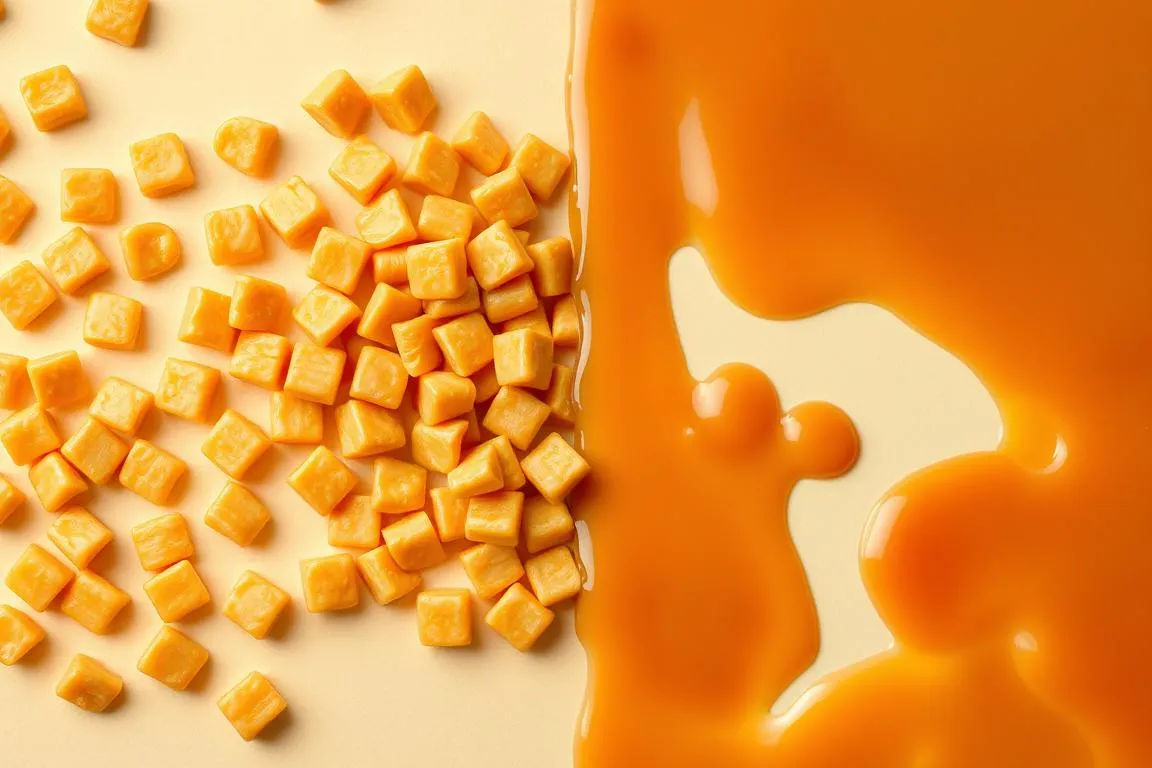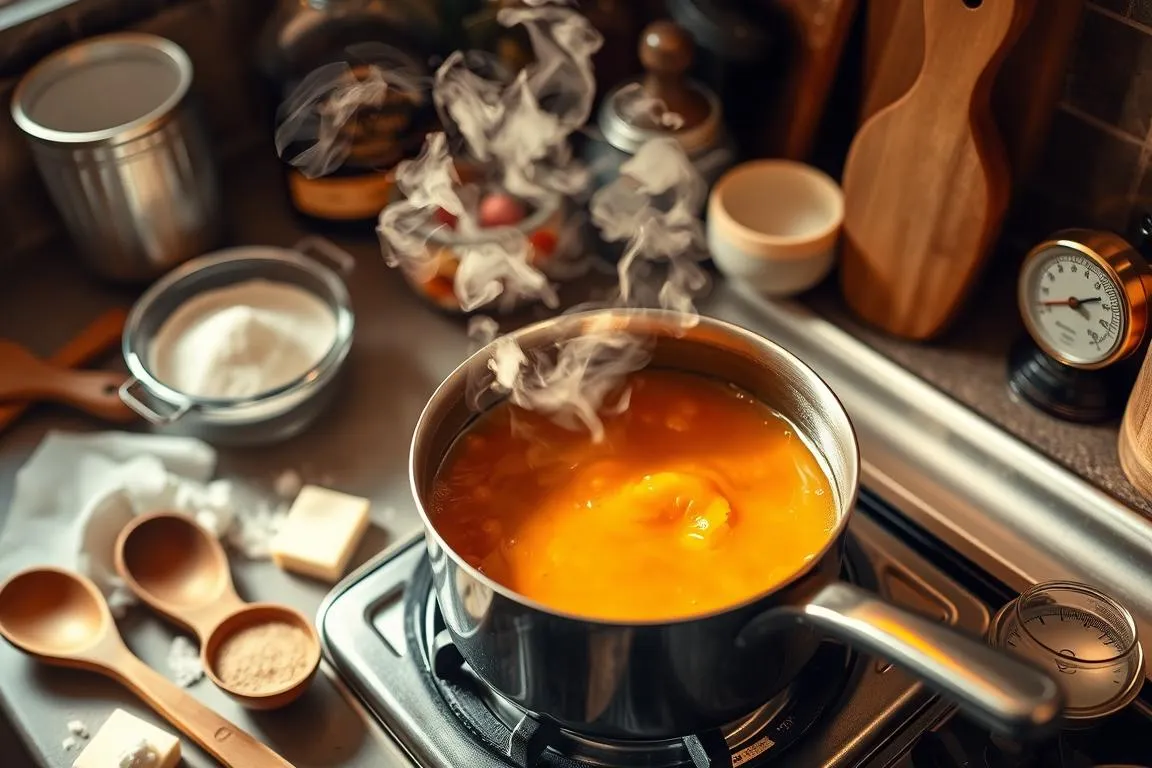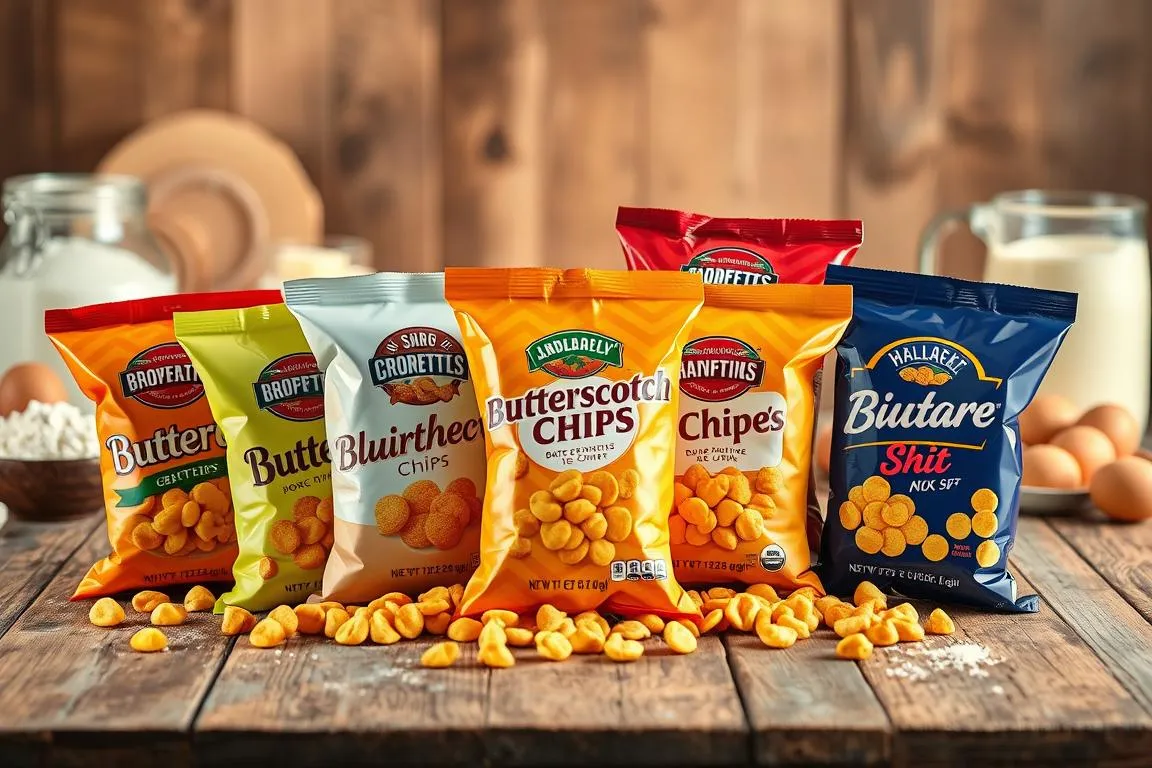Is butterscotch chips the same as caramel .Bakers and dessert lovers often get confused by butterscotch chips and caramel. They might look similar, but they have their own special qualities. These differences make them unique in the world of cooking.
Butterscotch chips and caramel give your baked goods a special taste. Knowing the difference helps you pick the best one for your recipes. This ensures your desserts taste great and feel just right.
Butterscotch chips and caramel are made differently, which affects their taste. Professional bakers choose carefully. They know the right sweet ingredient can make a simple recipe into a masterpiece.
Key Takeaways
- Butterscotch chips and caramel have distinct flavor profiles
- Ingredient composition differs significantly between the two
- Each sweet ingredient offers unique baking characteristics
- Understanding their differences enhances culinary creativity
- Professional bakers carefully select between butterscotch chips and caramel
Understanding the Basic Composition of Butterscotch Chips
Butterscotch chips add warmth and rich flavor to desserts. They are more than simple candies. They have a fascinating production process and a unique nutritional profile.
Key Ingredients in Butterscotch Chips
The ingredients in butterscotch chips are simple but key to their taste. The main parts are:
- Brown sugar
- Butter
- Vanilla extract
- Salt
- Milk solids
Manufacturing Process of Butterscotch Chips
The making of butterscotch chips involves careful temperature control and mixing. Here’s how it’s done:
- Caramelize brown sugar and butter
- Add vanilla and salt for flavor
- Cool and shape the mixture into chips
- Temper and package the chips
Nutritional Profile of Butterscotch Chips
Knowing the nutrition in butterscotch chips helps bakers choose wisely. Here’s a detailed look at their nutritional content:
| Nutrient | Amount per 1 oz Serving |
|---|---|
| Calories | 140 |
| Total Fat | 8g |
| Sugar | 14g |
| Protein | 1g |
“Butterscotch chips are a versatile ingredient that can transform ordinary recipes into extraordinary culinary experiences.” – Pastry Chef Expert
Now, home bakers and cooking fans can dive into the world of butterscotch chips. They can learn about their ingredients and how they’re made.
The Origins and History of Caramel Making
Caramel’s history goes back centuries, rooted in ancient sugar-working. It started with ancient civilizations discovering sugar’s magic when heated.
In the Middle East around 1000 CE, artisans began making caramel. They used heat to transform sugar. Soon, this art spread through trade routes, exciting chefs everywhere.
“Caramel is not just a flavor, but a culinary journey through time and culture.” – Culinary Historian
- Ancient sugar workers first discovered caramelization around 1000 CE
- Initial techniques involved slow heating of sugar
- Caramel spread through Mediterranean trade routes
Different cultures had their own caramel-making ways. European confectioners made it even better. They created sweet candies and sauces that are now key in desserts.
| Region | Caramel Technique | Primary Use |
|---|---|---|
| Middle East | Slow sugar heating | Confectionery |
| Europe | Refined sugar cooking | Dessert sauces |
| Americas | Industrial caramelization | Mass production |
By the 19th century, new ways changed caramel making. New technology made it easier and bigger, turning caramel into a worldwide favorite.
Is butterscotch chips the same as caramel
Baking fans often ask if butterscotch chips and caramel are the same. They look similar, but they’re not. Each has its own special qualities.
Chemical Composition Differences
Butterscotch and caramel differ in what they’re made of. Butterscotch chips mix brown sugar and butter for a unique taste. Caramel, on the other hand, uses white sugar heated to a golden color.
- Butterscotch: Brown sugar + butter
- Caramel: White sugar + water/cream
- Cooking temperature varies significantly
Flavor Profile Variations
Butterscotch and caramel taste different. Butterscotch has a deep, buttery flavor. Caramel is sweeter and simpler, with a sugar taste.
| Characteristic | Butterscotch | Caramel |
|---|---|---|
| Primary Flavor | Rich, Buttery | Sweet, Smooth |
| Sugar Type | Brown Sugar | White Sugar |
| Cooking Method | Lower Temperature | Higher Temperature |
Texture and Consistency Comparisons
Butterscotch and caramel also differ in how they feel. Butterscotch chips are hard and crystalline. Caramel is soft and pliable.
“Understanding the nuanced differences helps bakers choose the right ingredient for their culinary creations.” – Pastry Chef Sarah Thompson
So, are butterscotch chips the same as caramel? No, they’re not. Each has its own special qualities, making them both unique and delicious in their own ways.
Melting Properties and Baking Applications
Learning how to melt butterscotch chips can change your baking. It’s all about the right techniques to get the best texture and taste in your treats.
Butterscotch chips are special because they melt differently than other baking chips. They have a unique way of behaving when heated.
- Melting temperature ranges between 90-110°F
- Smooth consistency when properly melted
- Creates rich, buttery flavor profiles
“Mastering the art of melting butterscotch chips can elevate your dessert game.” – Professional Pastry Chef
Caramel in baking is sweet but different. Butterscotch chips melt smoothly, but caramel needs careful temperature control.
| Ingredient | Melting Point | Baking Performance |
|---|---|---|
| Butterscotch Chips | 90-110°F | Smooth, even distribution |
| Caramel | 338°F | Dense, intense flavor |
Experts say to heat butterscotch chips slowly. Slow, controlled melting prevents burning and keeps the flavor perfect.
For great baking, use a double boiler, stir often, and avoid high heat. Your desserts will be better for it!
Culinary Uses for Butterscotch Chips
Butterscotch chips are a versatile ingredient that can make ordinary desserts special. They add a rich, caramel-like flavor to many baking projects. This makes them a hit with both home bakers and professional pastry chefs.
Popular Dessert Recipes
Exploring butterscotch chip recipes opens up a world of tasty possibilities. Some classic favorites include:
- Butterscotch chip cookies
- Butterscotch brownies
- Butterscotch blondies
- Butterscotch pudding bars
Expert Storage Techniques
Keeping butterscotch chips fresh is key. Professional bakers suggest these storage tips:
| Storage Location | Temperature | Expected Shelf Life |
|---|---|---|
| Pantry | Room temperature | 6-8 months |
| Refrigerator | Cool and dry | Up to 1 year |
| Freezer | Sealed container | 18-24 months |
Professional Baking Tips
Here are some expert tips for baking with butterscotch chips:
- Coat chips in flour to prevent sinking in batters
- Use gentle heat when melting to maintain smooth texture
- Mix chips into cooled batter for best distribution
- Experiment with combination flavors like chocolate and nuts
“Butterscotch chips are not just an ingredient, they’re a culinary adventure waiting to be explored.” – Professional Pastry Chef
By using these techniques, you can fully enjoy butterscotch chips in your baking.
Traditional Caramel Making Techniques
Making homemade caramel is an art that needs precision and patience. It turns simple sugar into a rich, golden treat that makes any dessert better. Both professional chefs and home bakers love the detailed techniques needed to get it right.
There are two main ways to make caramel: the dry method and the wet method. Each method has its own challenges and rewards for those who want to improve their caramel skills.
Dry Caramel Method
- Spread granulated sugar evenly in a heavy-bottomed pan
- Heat sugar without stirring until it starts to melt
- Gently swirl the pan to ensure even caramelization
- Watch carefully to prevent burning
Wet Caramel Method
- Combine sugar and water in a clean saucepan
- Heat mixture until sugar dissolves completely
- Cook until mixture turns amber-colored
- Remove from heat immediately to stop cooking process
“The secret to perfect caramel is patience and constant attention.” – Professional Pastry Chef
Keeping the temperature right is key in making caramel. A candy thermometer helps you get exact results and avoid mistakes.
| Caramel Stage | Temperature Range | Color Indication |
|---|---|---|
| Soft Caramel | 320-340°F | Light Golden |
| Medium Caramel | 340-350°F | Deep Golden Brown |
| Dark Caramel | 350-370°F | Dark Brown |
Pro tip: Always use a clean, dry utensil when working with caramel to prevent crystallization and ensure smooth results.
Health Considerations and Dietary Impact
It’s important to know the nutritional facts of butterscotch chips and caramel. They have different health effects that can change your diet and well-being.
Sugar Content Comparison
Butterscotch chips have a lot of sugar, about 10-12 grams per serving. Caramel also has a lot of sugar, around 8-11 grams per serving.
| Ingredient | Sugar Content (per 1 oz) | Calories |
|---|---|---|
| Butterscotch Chips | 12g | 140 |
| Caramel | 10g | 120 |
Allergen Information
Butterscotch chips and caramel can have common allergens. These include:
- Milk proteins
- Soy derivatives
- Possible tree nut contamination
Dietary Restrictions
There are options for those with special diets. Gluten-free and vegan options are now available. This lets more people enjoy these treats while following their dietary needs.
“Always check labels carefully to understand the complete nutritional profile and possible allergens.” – Nutrition Expert
Storage Methods and Shelf Life
Storing butterscotch chips and caramel needs special care to keep them fresh. You must protect them from moisture, temperature changes, and contamination.
For butterscotch chips, a cool, dry place is best. Use sealed containers to keep them away from humidity and flavor loss. Caramel also needs careful storage to keep its rich taste and texture.
- Store in airtight containers
- Keep away from direct sunlight
- Maintain consistent cool temperature
- Avoid humidity and moisture exposure
The shelf life of baking ingredients depends on how you store them. Butterscotch chips stay fresh for 6-12 months if stored right.
| Ingredient | Room Temperature | Refrigerated | Frozen |
|---|---|---|---|
| Butterscotch Chips | 6-9 months | 12-18 months | Up to 2 years |
| Caramel | 3-6 months | 6-12 months | 12-18 months |
*Pro Tip*: Always check for signs of spoilage such as unusual odors, discoloration, or crystallization before using stored baking ingredients.
Temperature control is critical for storing baking ingredients. Refrigeration can help, but make sure containers are sealed well to avoid moisture.
By sticking to these storage tips, you’ll keep your butterscotch chips and caramel fresh. This ensures your baked goods turn out great every time.
Popular Brands and Market Options
Finding the right butterscotch chips can be tough for those who love to bake. It’s important to know the top brands and what makes them stand out.
When picking butterscotch chips, you want them to make your baked goods better. There are many trusted brands known for their great taste and quality.
Top Butterscotch Chip Manufacturers
- Nestle Toll House: Known for consistent quality and rich flavor
- Guittard: Premium chips with authentic butterscotch taste
- King Arthur Baking: Artisan-style butterscotch chips
- Ghirardelli: Gourmet baking chips with superior texture
Quality Assessment Guide
Choosing the right butterscotch chips means looking at a few important things:
- Ingredient purity
- Flavor intensity
- Melting properties
- Texture consistency
| Brand | Flavor Profile | Price Range | Best For |
|---|---|---|---|
| Nestle Toll House | Classic sweet butterscotch | $3-$5 | Cookies, brownies |
| Guittard | Rich, deep butterscotch | $6-$8 | Gourmet desserts |
| King Arthur Baking | Authentic, natural taste | $5-$7 | Specialty baking |
| Ghirardelli | Smooth, creamy texture | $4-$6 | Chocolate-based recipes |
Pro tip: Always check the ingredient list and look for natural, high-quality components when selecting butterscotch chips for your recipes.
“The secret to great baking is using the best ingredients possible.” – Professional Pastry Chef
Common Substitutes and Alternatives
Bakers and home cooks often look for butterscotch chip substitutes. This is when their pantry is low or they have dietary needs. Knowing about alternative ingredients can change your baking and open new doors in cooking.
“Creative substitutions can elevate your recipe from good to extraordinary!” – Professional Pastry Chef
Looking into dairy-free butterscotch options is a tasty way to meet different dietary needs. These options let everyone enjoy sweet flavors without losing taste or texture.
Top Butterscotch Chip Substitutes
- Caramel chips
- White chocolate chips
- Toffee bits
- Homemade butterscotch sauce
For those looking for caramel alternatives, many ingredients can match the classic taste. They also meet nutritional needs.
| Substitute | Flavor Profile | Dietary Considerations |
|---|---|---|
| Maple Syrup | Rich, sweet | Vegan, natural |
| Date Syrup | Deep caramel notes | Dairy-free, unrefined |
| Coconut Sugar Caramel | Robust sweetness | Low glycemic index |
When picking butterscotch chip substitutes, think about what your recipe needs and how sweet you like it. Try different ones to find your favorite.
Dairy-Free Butterscotch Options
- Coconut cream-based butterscotch
- Almond milk caramel sauce
- Cashew-based butterscotch chips
Professional bakers suggest trying substitutes in small amounts first. This way, you can get the best results. Each option has its own special qualities that can make your dishes even better.
Troubleshooting Common Issues in Recipes
Baking with butterscotch chips can be tricky for home bakers. Knowing how to fix common problems will make your desserts taste great. This guide will help you solve texture and temperature issues in butterscotch recipes.
Professional bakers say that caramel problems usually come from not controlling the temperature right. Butterscotch chips need careful handling to avoid burning or texture changes.
Temperature Control Techniques
- Use a digital candy thermometer for accurate readings
- Maintain consistent medium-low heat when melting chips
- Stir frequently to prevent scorching
- Remove from heat immediately when desired consistency is reached
Texture Problem Solutions
Texture is key when baking with butterscotch chips. Grainy or clumpy results often mean there’s too much moisture or the temperature was off.
- Prevent moisture contamination by using dry utensils
- Microwave chips in 15-second intervals, stirring between each
- Add a teaspoon of vegetable oil to smooth out texture
- Allow chips to cool gradually for best consistency
“Precision is the key to perfect butterscotch chips” – Professional Pastry Chef
By mastering these techniques, your baking will go from amateur to professional. You’ll be able to fix common problems with butterscotch chips.
Conclusion
Exploring butterscotch chips and caramel opens up a world of flavors for both home bakers and chefs. The key differences in ingredients and cooking methods make baking with these ingredients an art. This artistry turns simple recipes into something special.
Butterscotch chips and caramel each add unique flavors to recipes. Butterscotch chips have a sweet, buttery taste and melt well. Caramel, on the other hand, has a deeper flavor. Choosing the right one can change a dessert’s taste completely.
Mastering these ingredients lets you get creative in the kitchen. Knowing how they melt and taste helps you use them in your baking. This way, you can make traditional recipes even better with your own twist.
Starting with basic differences and moving to advanced techniques shows the possibilities of these ingredients. As you keep trying new things, remember that learning is what makes cooking an art. It turns a simple task into a creative journey.
FAQ
What’s the main difference between butterscotch chips and caramel?
Butterscotch chips are made with brown sugar and butter. This gives them a unique taste. Caramel, on the other hand, is made by heating white sugar. It gets a rich, deep flavor.
Can I substitute butterscotch chips for caramel in recipes?
They share a similar sweetness, but they’re not the same. Butterscotch chips are solid, while caramel is a sauce. Whether you can substitute them depends on the recipe and texture you want.
Are butterscotch chips dairy-free?
Traditional butterscotch chips have dairy because of the butter. But, some brands now make dairy-free versions. These use vegetable oils for those with dietary restrictions.
How long can I store butterscotch chips?
Keep them in an airtight container in a cool, dry place. They last 6-12 months. Always check the expiration date and for any signs of spoilage.
What baking recipes work best with butterscotch chips?
They’re great in cookies, brownies, blondies, pancakes, and muffins. They melt well and add a rich flavor to sweet and savory treats.
Are there any nut-free butterscotch chip options?
Yes, many brands offer nut-free butterscotch chips. Always check the packaging for warnings about cross-contamination, though.
How do I prevent butterscotch chips from sinking in batter?
Toss the chips in flour before adding them to the batter. This keeps them from sinking and ensures they’re evenly distributed.
Can I make homemade butterscotch chips?
Yes, you can make them at home. Mix brown sugar, butter, and other ingredients carefully. But, getting the exact texture of store-bought chips can be hard.
What’s the nutritional difference between butterscotch chips and caramel?
Butterscotch chips have more sugar and fat, with about 70-80 calories per tablespoon. Caramel’s calories vary, but it’s similar. Both should be eaten in moderation.
Are there any vegan butterscotch chip alternatives?
Yes, many brands now make vegan butterscotch chips. They use plant-based oils and sweeteners. Look for brands that cater to vegan diets.



